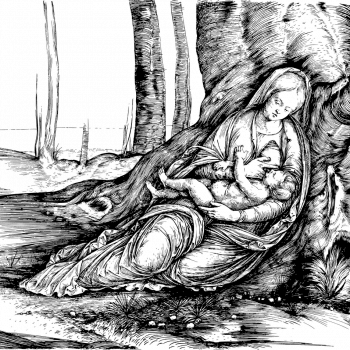January is mid-winter, the cold, “dark” time of the year. Winter is our time to go within, to rest and restore, to re-assess and re-new, in preparation for the explosive/dramatic birth to come in Spring. It is the time of rejuvenation and great creativity of the Divine Feminine, of strengthening Nature’s forces for new growth. In this context, I want to look at the journey of the mother, and the priesthood of motherhood, as the foundational example of the Divine Feminine in our world.
The journey of the mother-priest is the critical one of carrying, loving and nurturing of our children, our future. I believe there are many connections between motherhood and the historical priesthood of women. In both cases the purpose, process and outcome is very much larger than the individual people involved. To the extent that the priesthood of women has been rejected and even condemned by the patriarchy of most organized religions of the western world and beyond, the patriarchy is fully responsible for every inequality we see today regarding women. This reflects an ignorance of both historical precedent and true understanding of the nature of Divinity, for true priesthood is gender-blind.
The ancient priestesses of Rome and the Celtic lands were the trusted keepers and sustainers of the fire. The duty of the priestesses of the Roman goddess Vesta, the goddess of the hearth, was to sustain the “sacred fire,” at all costs. The prosperity and safety of Rome was believed to be dependent on this sacred fire. For the Celtic people, the interior and the exterior worlds are part of a single divine flow. Fire is fire, whether it warms the home, animates the forge, or inspires poetry.
Fire is in its essence vitality, passion and longing, emanating “new life,” carrying with it the inspiration and generative powers of the new generation. Fire is necessary to the maintenance of the present and the creation of the future. This task of maintaining and sustaining the fire was/is entrusted to women-priests.
The young girl/the initiate enters the temple with neither the full knowledge of what would be expected of her, nor of what would be bestowed upon her. But knowledge comes to her nevertheless, through the focused daily performance of her sacred duties. Her ability to know is the result both of her innate ability and her learned ability to access the deeper mysteries and to live deep within the reality of those mysteries.
The Holy Vigil of these guardians is one of constancy and patience. These qualities of the ancient priestesses – constancy and patience – are the same as those required of the young mother, for she too enters the temple unprepared, but open. It is a steep learning curve. Hers, too, is a sacred task.
Falling in Love with our children
Kahlil Gibran in his extraordinary text The Prophet, reflects on the nature of the relationship between parents and children.
Gibran writes:
Your children are not your children.
They are the sons and daughters of Life longing for itself.
They come through you but not from you,
And though they are with you yet they do not belong to you.
When I was in my twenties, I built a large wooden sculpture composed of two parts. Inspired by the Wordsworth poem “Intimations of Immortality” it seeks to tell the “journey of life” from the heavenly “launching pad” as Fr. Seán ÓLaoire describes it onward through the decades, and ultimately to death. Birth is represented as a child setting out on a small raft with a single pole for pushing through the water and for steering. The raft is what the child knows to be true. The development of child and raft is making everything “journey ready.” Nurturing and supporting this development is the sacred task of the mother.
In pregnancy the young mother opens to mystery. She embarks on a path which she shares with literally billions of women before her. This path is the creation of Nature, of “life longing for itself,” as Gibran writes. Its awesome power, its driving force is much, much bigger than the individuals involved. This connection with the waves of power of “life longing for itself” is met and recognized in particular in the birthing process, as ever-intensifying waves of energy that she moves/surrenders into obedience to.
Among the first signs of life of the presence of mystery is the arrival of a strong sense of intuition, perhaps a “knowing” that one is pregnant before a doctor or a test confirms it. The young mother finds that her body experiences a heightened sense of awareness of colors, sights, sounds, tastes, feelings and an immediate visceral response to what is nurturing and supportive in the environment and what is not.
She is growing physically, emotionally, mentally and spiritually in her connection to the baby she carries, who is in some amazing way, not a stranger. She deepens in her connection to Nature and to all life, to the constantly unfolding mystery of the emanation of the Divine.
Is this connectedness not an attribute of priesthood?
As the months pass by, the baby begins to express his/her personality through sleep patterns, ways of kicking and rolling, particularly active periods of the day and night. The baby is already unique, already expressing his/her own rhythm.
Safeguarding, nurturing and guiding
With the birth of the baby, the mystery deepens. Mother and child are bound to each other. I realized that for the first time in my life, there was someone I would give up my own life to protect.
The physical responsibilities and energy output are huge, especially in the early months. One is completely focused on the health of the baby, on everything he/she needs in the way of organic nutrition, clean water, fresh air, activity, and most importantly, love. The care of children forces us into the now – into what is happening right now and what needs to be done about it.
Is this mindfulness not an attribute of priesthood?
The baby, with his/her wide-open eyes has begun an all consuming study of the mother as well. He/she is totally focused on learning about her. Mother and baby mirror each other. If she feels stressed from lack of sleep, the baby is also fussy. In time, the baby will learn what makes the mother happy and will start to reproduce those behaviors. In this way, the baby will draw the virtues of love and kindness from the mother.
Gibran writes:
You may give them your love but not your thoughts,
For they have their own thoughts.
You may house their bodies but not their soul. . .
Children are given into our safe-keeping. It is not for us to change them, but rather to learn through observation, curiosity and patience who this precious soul is and to nurture and support whom and what we see. To the best of our ability, we are to do no harm.
There is great poignancy in child-rearing, to drink daily from this intoxicating cup of love, adventure, and shared experiences, knowing that we have only a certain amount of time and they will grow up. And, one inevitably finds that the time goes all too quickly. The lesson here is the willingness to surrender to life.
Is this not priesthood?
Setting them free
This is the fulfillment of the mystery, the time to step back, and release children to fly. It begins with introducing a widened environment, a new world of experiences outside the family circle. Outside influences gain strength and conversations ensue about how other families “do life.”
I find that the hardest thing is to let one’s children have their lessons. It requires an equanimity that is hard to muster at times. Our sense of protectiveness and desire to keep our children from hurt is overwhelming. I wonder, if the ancient oracles experienced this as they displayed the truth to those who sought their counsel, and then watched as that seeker chose a different path.
Gibran writes:
“You are the bows from which your children as living arrows are sent forth.
The archer sees the mark upon the path of the infinite, and He bends you with His might that His arrows may go swift and far.”
What is the nature of the arrow and the bow? Built into the arrow are the lessons the child has come to learn. Built into the bow are life experiences and lessons still to learn.
If I were to make an arrow, I would seek a light weight wood, strong and straight, in order to maximize flight and accurate trajectory. In reading about this, I found that the ideal bow stave is between five and six feet long, of uniform width, straight, strong and most importantly flexible. Pine it seems is an unsuitable choice, because it tends to break rather than bend.
Interestingly, pine is one of the most common woods used for arrows. Apparently what suits the nature and purpose of the arrow, does not suit the nature and purpose of the bow. Different qualities are required. The arrow must be light and strong enough to fly straight and sure, the bow must be straight as well, but flexible and able to bend without breaking.
Our mission as parents is to nurture the “straightness,” the integrity, the essence of the arrow, while maintaining a strong, yet flexible bow, with an ability and a willingness to bend in the hands of the Archer to ensure accordingly that the arrow finds the mark upon the path that it seeks.
What could be a more worthy task, a more divine mission, than to live within this mystery, which teaches unconditional love, kindness, surrender, mindfulness, equanimity, constancy, patience, resilience, wisdom and intuition, while protecting, nurturing and supporting the very vitality of life and the future – all attributes of the Divine Feminine? All of these virtues shape and mold one to be able and prepared to access mystery.
Priesthood is in essence the ability to access mystery; the journey of the mother is the journey to priesthood.













